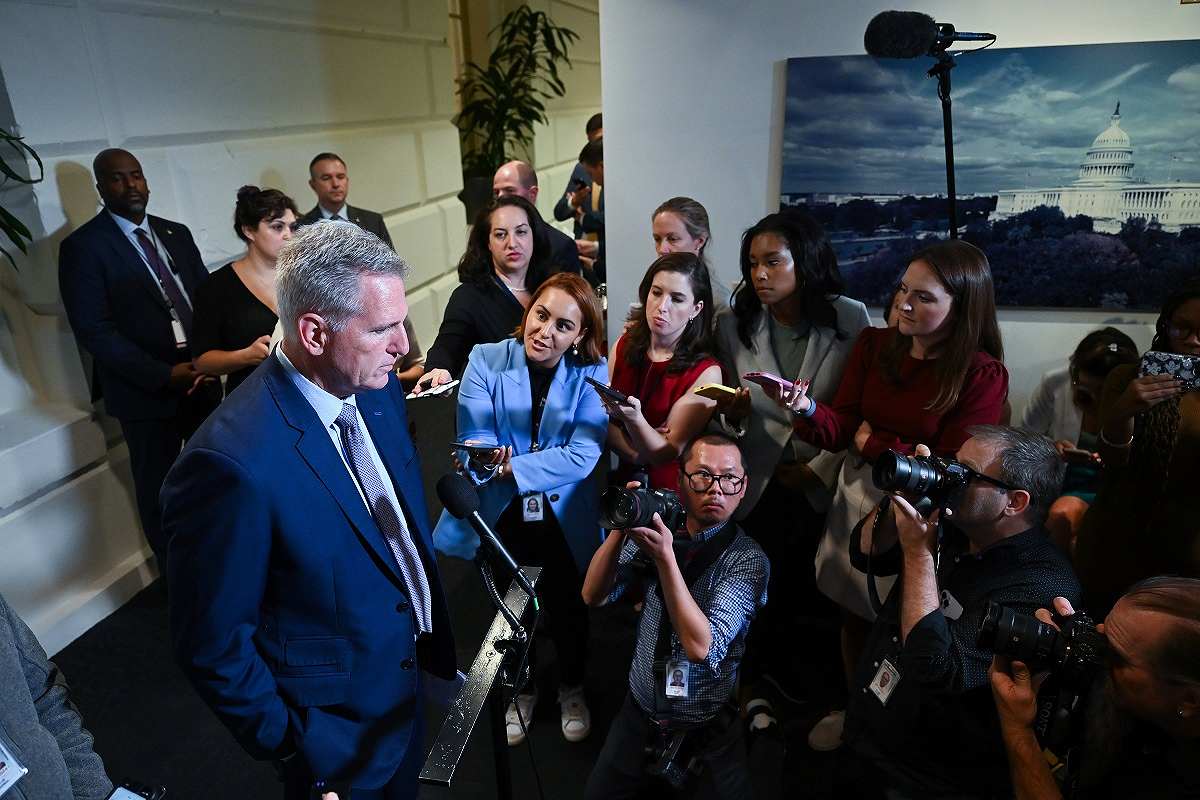
House Speaker Kevin McCarthy (R-Calif.) on Tuesday at the Capitol.
14:22 JST, September 22, 2023
The United States is barreling toward a possible government shutdown at 12:01 a.m. Oct. 1.
Members of Congress are negotiating and renegotiating plans to fund the government past the deadline through a short-term mechanism called a continuing resolution, or CR. Some proposals include spending cuts that would pare back anti-poverty programs and assistance for Ukraine. Others would preserve the federal government’s current spending levels while adding new money for domestic disaster recovery.
The idea is to avert a shutdown now with a CR, then use the extra time to enact spending laws that fund the government through the rest of the fiscal year, until Sept. 30, 2024.
House Republicans are negotiating among themselves on a deal that could include legislation on border security and policies to rein in the FBI’s authority. Yet there are holdouts among GOP hard-liners who insist on even more spending cuts. The Senate has not yet passed its own temporary spending bill but is not expected to have difficulty doing so before the deadline.
Here are the different budget scenarios involved in the dispute, and what you need to know before a potential government shutdown.
Current spending levels
The 2023 omnibus appropriations bill, the legislation that funded the government for most of the current fiscal year, covered $1.7 trillion in spending, including $772.5 billion for nondefense discretionary programs – such as veterans’ medical care, anti-poverty food assistance, and the National Institutes of Health and Centers for Disease Control and Prevention.
The Biden administration in August formally asked Congress to preserve spending at those levels in a short-term continuing resolution as negotiations continue on longer-term spending bills.
“Although the crucial work continues to reach a bipartisan, bicameral agreement on fiscal year 2024 appropriations bills, it is clear that a short-term continuing resolution (CR) will be needed next month,” a spokeswoman for the Office of Management and Budget said on Aug. 31.
The White House also requested an additional $20.6 billion in emergency aid for Ukraine, $12 billion for domestic disaster relief and $1.4 billion for the Women, Infants and Children nutrition program, known as WIC, which helps impoverished families pay for healthy food.
Democrats have strongly hinted that they will not support a continuing resolution without Ukraine aid. Asked what would happen if U.S. assistance stopped flowing to Ukrainian defense counterparts, Sen. Mark Kelly (D-Ariz.) said Wednesday, “They lose.”
“I think government shutdowns are really bad,” said Kelly, who returned from a trip to Kyiv earlier this week. “At the same time, I think its unconscionable to think we would not support the Ukrainian people.”
The debt ceiling agreement
President Biden and House Speaker Kevin McCarthy (R-Calif.) reached an agreement in May that most of Washington thought would make a standoff such as the current one less likely.
In exchange for suspending the debt ceiling – the total amount of money the federal government is allowed to borrow to make payments Congress has already authorized – until 2025, the White House agreed to limit federal spending going forward. That deal capped growth in discretionary spending – some social services, scientific research, international affairs and more – to 1 percent per year. That’s essentially a spending cut in real dollars, because inflation runs higher than 1 percent.
The deal also clawed back funding for the Biden administration’s planned IRS overhaul, money that was set to help the tax agency modernize and go after wealthy tax cheats, and imposed new work and age requirements on people who receive anti-poverty assistance, among other policies.
That legislation, which passed with bipartisan support, was supposed to smooth the work this month, before the government funding deadline, because it set limits for federal spending – which both chambers had already agreed to. For the 2024 fiscal year, the total would be $1.59 trillion. Senate appropriators have largely used that number to guide top-line spending, with some minor additions.
But the House Freedom Caucus, a group of the most ardent Republican hard-liners, never liked that agreement, which members say runs counter to McCarthy’s promises to cut spending. House conservatives want to spend less than the limit.
Rep. Matt Gaetz (R-Fla.), a member of the Freedom Caucus, said earlier this month that McCarthy was “out of compliance” with the agreement he reached with conservatives who backed him for speaker, and that a stopgap spending deal would be an “automatic trigger” for an attempt to remove McCarthy from power.
The House’s continuing resolution
McCarthy has backed a number of frameworks in attempts to get his hard-right flank on board with the mainstream of his caucus. The latest draft plan, reached Wednesday night, would fund the government for 30 days at 2022 spending levels, roughly $1.47 trillion, with a border security bill the GOP-controlled House passed earlier this year attached.
That legislation would approve funding to restart construction of a wall along the Mexican border, enhance border-monitoring technology and allot millions of dollars to increase the number of Border Patrol agents. The deal does not include money for Ukraine’s defense against Russia’s invasion 18 months ago nor emergency assistance for communities hit by natural disasters.
The proposal is still not a done deal in the House, though. McCarthy is facing resistance from some members of the Freedom Caucus, but two key holdouts, Reps. Ralph Norman (R-S.C.) and Ken Buck (R-Colo.), said Wednesday night they would back this new agreement. That could be enough support for the package to win approval, but any last-minute defections or unexpected absences could sink the vote.
That package also could increase the odds of a government shutdown: It would be a nonstarter in the Democratic-controlled Senate, where both parties have less of an appetite for spending cuts and there is wide support for Ukraine and disaster recovery funding packages. And the two chambers – even working through the weekend – still might not have enough time to negotiate and pass a short-term funding bill before the Sept. 30 deadline.
After a procedural vote to advance a Pentagon funding bill was defeated Thursday, McCarthy sent lawmakers home seemingly without a clear path forward on short-term or long-term government funding legislation.
The House Freedom Caucus plan
The Freedom Caucus itself has divisions. Reps. Scott Perry (R-Pa.), Chip Roy (R-Tex.) and Byron Donalds (R-Fla.) negotiated an earlier short-term spending bill with more mainstream GOP spending hawks. But that package lacked sufficient support from other Freedom Caucus members to advance, and it never came to a vote in the House.
The group has other holdouts who could thwart McCarthy on an otherwise party-line vote.
So what does the Freedom Caucus want? In the purest form, members do not want a continuing resolution, and instead want to fund the government through a series of 12 appropriations bills. But passing a dozen separate pieces of legislation takes a lot of time, and Congress would not finish it by Sept. 30. As of Thursday, the House had passed only one of the 12, and the Senate had not passed any, though it’s working on a “minibus” that wraps several of them together.
The Freedom Caucus in August said it would only back legislation that cuts top-line federal spending to 2022 levels, around $1.47 trillion, down from $1.7 trillion in 2023, and includes new border security provisions. Members also want any spending law to address what the group called the “unprecedented weaponization of the Justice Department and FBI,” eliminate what members consider to be “woke” polices within the Defense Department and eliminate funding for Ukraine.
Some of those conditions were met in the McCarthy plan. Others were not. And the Freedom Caucus remains divided, though with fewer holdouts than before.
The group’s position grew more tenuous Wednesday evening. Former president Donald Trump wrote on his Truth Social platform that Republicans should not support a government funding bill unless it defunds the federal prosecutors bringing charges against him.
That reinforced at least one Freedom Caucus member’s opposition to the McCarthy continuing resolution.
“Trump Opposes the Continuing Resolution,” Gaetz posted on the social media platform X, formerly known as Twitter. “Hold the line.”
"News Services" POPULAR ARTICLE
-

American Playwright Jeremy O. Harris Arrested in Japan on Alleged Drug Smuggling
-

Japan’s Nikkei Stock Average as JGB Yields, Yen Rise on Rate-Hike Bets
-

Japan’s Nikkei Stock Average Licks Wounds after Selloff Sparked by BOJ Hike Bets (UPDATE 1)
-

Japanese Bond Yields Zoom, Stocks Slide as Rate Hike Looms
-

Japan’s Nikkei Stock Average Buoyed by Stable Yen; SoftBank’s Slide Caps Gains (UPDATE 1)
JN ACCESS RANKING
-

Keidanren Chairman Yoshinobu Tsutsui Visits Kashiwazaki-Kariwa Nuclear Power Plant; Inspects New Emergency Safety System
-

Imports of Rare Earths from China Facing Delays, May Be Caused by Deterioration of Japan-China Relations
-

University of Tokyo Professor Discusses Japanese Economic Security in Interview Ahead of Forum
-

Japan Pulls out of Vietnam Nuclear Project, Complicating Hanoi’s Power Plans
-

Govt Aims to Expand NISA Program Lineup, Abolish Age Restriction



























